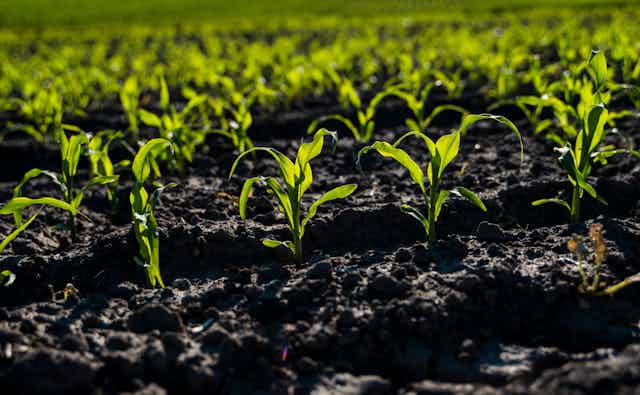The soil beneath our feet is a living entity. It is home to many microbes on Earth responsible for crucial processes such as decomposition and supporting plant health.
Organic compounds in the soil, such as humus – made from decomposed plant and animal matter – play a crucial role in maintaining soil’s structure, by acting as a bonding agent between soil particles. Similar to the walls of a building, healthy soil acts as a structure that allows water to flow, prevents erosion and provides habitats for organisms.
Healthy soil also helps people get safe and nutritious food, and is especially important for people including farmers and indigenous communities in developing nations.
Yet, more than a third of the soil worldwide is now degraded, or facing issues such as hardening, erosion, nutrient degradation and increased salinity.
Degraded soil can result in lower crop yields and poorer food quality. It also reduces water supply and increases drought risks. It may also increase the risks for floods, as the soil loses its ability to hold and filter water.
This article will share major factors behind soil degradation, and why we need governments worldwide to do more to take better care of our soil.
Soil destroyers
The global agriculture industry’s excessive use of fertiliser seriously damages the microbiological ecosystem in soil. This in turn makes the industry more dependent on expensive fertiliser and pesticides.
Modern ways of growing crops such as corns and potatoes often prioritise maximising high yields by using more nitrogen fertiliser than necessary. This releases nitrous oxide – a greenhouse gas 300 times more potent than carbon dioxide at trapping heat in the atmosphere.
In addition, aggressive soil cultivation practices – such as deep plowing with heavy machinery – have risen significantly over recent decades. These practices crush organic matter hidden within soil clumps, resulting in serious loss of biodiversity.
Human activities are putting too much stress on soil resources, and we are reaching a point where the soil can no longer sustain us. This not only endangering biodiversity but also disrupting food supplies, potentially pushing millions into poverty.
The global significance of healthy soil
A 2020 study by the International Union for Conservation of Nature found that healthy soils and landscapes can enhance crops’ ability to withstand the detrimental effects of climate change, such as drought or flood.
Improving our understanding of soil can also advance economic and climate goals.
The IUCN report found that increasing soil organic carbon by 0.4% annually in the first 30-40cm of soil may increase global production of major food crops, such as corn, rice and wheat, in some cases between 20-40% per year.
Boosting soil organic carbon in the world’s agricultural land by that much could increase carbon capture by croplands and grasslands by approximately 1 gigatonne per year over the next 30 years. That would be equivalent to capturing 10% of the world’s greenhouse gas emissions from human activity in 2017.
However, enhancing soil fertility is not as simple as pouring fertiliser out of a bag. Governments need to work together at the global, regional, and national levels to collectively improve soil health.
Better policies to soil museums: how governments can help
There are many existing soil initiatives around the world that governments can learn from.
First, governments need to create policies that encourage farmers or land managers to implement environmentally friendly practices.
One example is the “carbon farming” policy implemented by the European Union, which provides financial incentives to farmers or land managers who adopt eco-friendly practices. These practices include diversifying crops, planting leguminous plants, such as peanuts or lentils, and practising agroforestry (integrating trees and shrubs with crops or livestock).
These actions help to increase carbon sequestration in soils and support a healthy ecosystem with beneficial organisms, such as bacteria, fungi, protozoa and nematodes.
Brazil, China, India, Indonesia and Thailand have led globally in reducing chemical fertiliser subsidies. To improve soil fertility and biodiversity, governments need to direct subsidies towards a biological solution that involves using bio-fertilisers and science-based composting.
Second, governments can participate in global initiatives aimed at improving soil quality.
International organisations, such as the UN Sustainable Development Solutions Network, bring together experts, governments, the private sector and environmental organisations to emphasise critical environmental issues, including the significance of soil health.
The upcoming UN SDG Summit and UN Climate Change Conference (COP28) later in the year present opportunities for governments to recognise the feasibility and economic viability of large-scale soil ecosystem restoration.
Third, educating the general public about soil science is also essential.
For instance, soil museums – located in various regions around the world – serve as an effective means of educating people about different types of soil, how they are formed, their uses and threats, as well as ways to protect it.
Nurturing the symbiotic relationship between human and life in soil requires a mindset change. Doing so will improve citizens’ understanding and respect for the nutrient recycling mechanisms that nature itself has developed and relies on.


